One overcast afternoon in late July I took a train to Norfolk. It seemed a good time and place to catch up on the state of the avant-garde. My goal was the British Art Show 8, currently spread over several venues in the centre of Norwich and due next month to move on to Southampton, the final resting-point on its slow progress around what remains, for the moment at least, the United Kingdom.
Not having caught the exhibition at its previous stopping points, Leeds and Edinburgh, I thought this would be a suitable place to see it since Norwich is a town of art historical pedigree — home to Cotman, the Cromes and Michael Andrews.
In 37 years of peregrinations around Britain this is the very first time the show — an attempt at regular intervals by the Hayward Gallery to access newish art being made in Britain — has ended up in East Anglia. But, finally, on display in Norwich Castle Museum, plus on many floors and corridors of Norwich University of the Arts, is a multiplicity of works by 42 artists. Among them are a set of pictures made from a patchwork of old fur coats by Simon Fujiwara and several benches devised by Alan Kane from gravestones for visitors to rest upon.
One theme the avant-garde is preoccupied with at the moment, it seems, is recycling. That’s not unreasonable since a great deal of artistic innovation is deft recycling: of ideas, materials, idioms. The notion of the avant-garde itself has been around for long enough to count as an antique. Temperamentally, however, I’ve always had an instinctive sympathy for the opposite, the arrière-garde. And so, incorrigibly prejudiced in favour of painting and sculpture as I am, the works I liked best at Norwich tended to be those employing the most archaic idioms.
For example, I warmed to some by Daniel Sinsel in which he combines abstraction with very long-term recycling. He paints pictures, but also sticks little bits of mineral — including coprolite or fossilised dung — to their surfaces. At first glance you imagine these might be pigment squeezed straight from the tube, then you realise in fact you are looking at something previously excreted by a dinosaur.
There is — for this kind of exhibition — a surprising amount of painting on display around Norwich, including a whole wall of figurative pictures by Lynette Yiadom-Boakye whose Serpentine exhibition I reviewed for The Spectator last summer. Looking like portraits, these display her nice sense of tone and touch, all depicting black people but apparently of imaginary figures.
A French-born artist, Caroline Achaintre, was one of several doing unexpected things with what used to be thought crafts, in her case weaving rugs. She has made a number of shaggy textiles that hang on the wall — funny and mildly disturbing — a bit like splashy abstract paintings and somewhat resembling faces or tribal masks.
Also in the traditional-media-with-a-quirky-twist department, Ryan Gander contributes, among other more conceptual things, a series of meticulously naturalistic wood carvings of completely random objects — a paper weight and a large plastic ice-cream tube, a crate for transporting pictures and a cow’s muzzle — under the title, ‘The Way Things Collide’.
These strike me as a good idea. Why always depict or represent objects that conventionally go together, such as bowls of fruit or fish on plates? Admittedly, other aspects of Gander’s installation — including a filmed narration of a children’s book about Trellick Tower — left me baffled. But then, that is par for this kind exhibition; if you experience intervals of non-bafflement you are doing fine.
Film/video art is my aversion, partly because of the suspense: you never know when they are going to end. Nonetheless, I persist in entering dark spaces and looking at them. In the film-art category of the show, Rachel Maclean was the obvious star. Her contribution, a combination of sci-fi, children’s kitsch, and horror in which the artist plays all the roles, was so sharply put together and so watchable that one suspects she may follow the course of other stellar video artists such as Steve McQueen. That is, stop showing in art galleries, and start making them for cinemas.
Video, however, seems less the rage in 2016 than crafts and recycling. Under the latter heading, perhaps, comes an art work consisting of the restoration of a 1275 Mini GT made at Longbridge in 1979 (a project by Stuart Whipps). At the moment only the seats are on view, upholstered in a shade of mousey beige and impregnated with the dismal zeitgeist of the distant era when the Callaghan government collapsed and the very first British Art Show took place.
A lot has changed since 1979, and will no doubt alter in the future. In five years time, for example, we may be contemplating an English and Welsh Art Show (though somehow I doubt it). But, in a mutable world there are certain reassuringly fixed points. Whatever happens, it seems likely the avant-garde will always be with us.






Comments